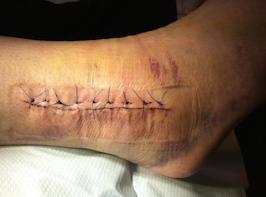
Stitches
After an operation, a patient will have wounds that been closed with stitches, also known as sutures. These may be buried and absorbable, in which case they will not require removal. Sometimes the ends are sticking out through the skin and may simply require trimming of the ends at the skin. Non-absorbable sutures, for example nylon or metal skin sutures will need removal. After an operation, on discharge from hospital, it is a good idea to ask what type of stitches are in a wound so that you know what to expect at the clinic on your next appointment. All early scars are sensitive scars!
Wounds take a variable amount of time to heal. The location of the wound makes a difference, as peripheries like your foot heal slower than your shoulder for example. Other factors such as smoking, using steroids, diabetes or low protein levels also slow wound healing. Slow healing can also allow an infection to set in. This may resemble a painful redness around the wound or it may start oozing fluid. If this happens, you should contact your doctor or local wound care clinic.
Sensitive Scars
Once the wound has healed, the scar can be quite tender, particularly in the hand or foot, but can occur anywhere in the body. Tapping the healed scar and deep massage around the scar are two excellent ways of speeding up the scar desensitisation process.
Tapping the scar site is done with your finger tip about twice per second for 3 minutes until the scar feels less tender. Start again at a different site. Do this as often as possible until you feel relief of the tenderness. This exercise should be done as many times as possible throughout the day.
Scars are not just skin deep. They may involve several layers beneath the skin which are stuck together. Deep friction massage is an excellent way of stretching the deep tissue. Start in the centre of the scar and move the skin slowly in 4 different directions. Most health care practionners recommend skin cream or ointment for superficial massage. It is also useful not to use skin cream or ointment to achieve a better skin grip for massaging deeper layers.
My scar is hot and red
Frequently,a healing scar will have a greater blood supply to it because the skin and underlying tissues are continuing to strengthen and thicken. With movement of the affected limb(for example, after doing some rehabilitation exercises) or a change in temperature (for example, after exposure to the cold or a hot bath), the scar can become warm and red. This should not cause concern as it will continue to do this for some time after the surgery. Eventually, after several months, the scar will become the same colour as the skin around it. Silicon patches have some use in the reduction of scar redness. Occasionally, a scar can be raised above the surrounding skin- known as a hypertrophic scar or keloid. Check this with your physician.